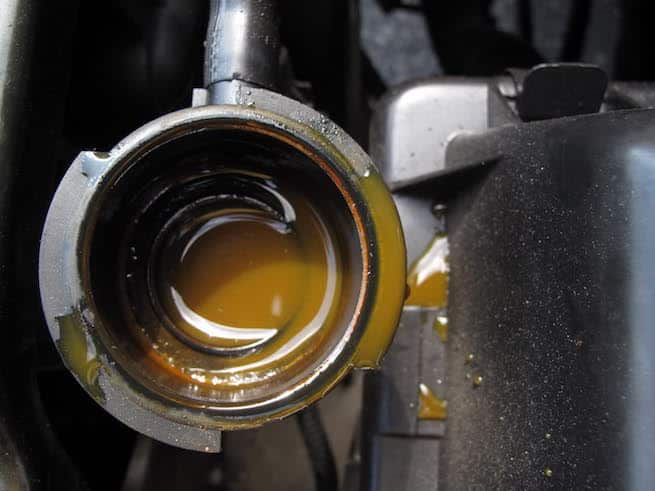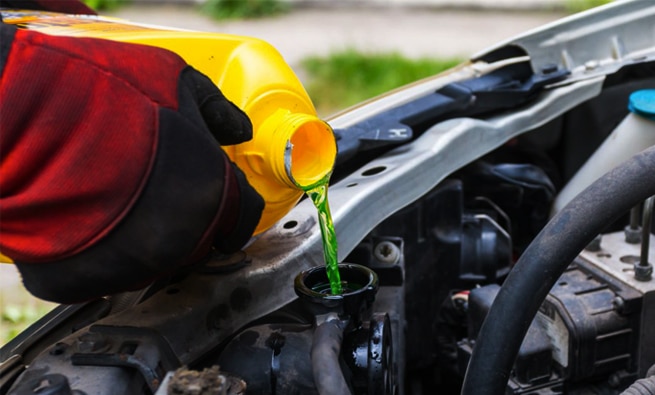How to Flush Your Car Cooling System? | 12 Steps To Do So
Beyond the comforts presented by being able to regulate the temperature inside your vehicle, your automobile cooling and heating systems are essential in averting your ride from breaking down due to extremely high operating temperatures.
It’s particularly vital to check your vehicles cooling and heating systems during the weeks preceding the winter and summer seasons. But it’s usually advisable that you check these systems every time you perform routine maintenance on your vehicle. This article explains how to flush your car cooling system by yourself.
When you drive, your vehicle’s radiator uses a mixture of coolant and water to help in lowering the operating temperature in your vehicle engine system. Just like any other liquid, coolant has a propensity to breakdown over time, and this is the reason why you need to replace it once in a while.
12 Steps on Flushing The Entire Cooling System Of Your Vehicle

A couple of days before attempting to do a cooling system flush, you need to use a radiator cleaner. This product helps to loosen up and contaminants or debris that is accumulated in the car radiator and cooling system.
Make sure you drive the vehicle like you normally would for a few days before you attempt flushing the radiator. Now you are ready to follow these steps:
1. Wait for your engine to cool
Before you touch any parts of your vehicles radiator, make sure the engine is cool. Don’t touch either the upper radiator hose or the lower radiator hose. Also, don’t attempt to remove the radiator cap off if your vehicle has been running because hot coolant can severely burn your skin.
If you were driving, then you need to park your vehicle in a safe piece of real estate away from animals and children. Shut-off the engine and wait until the cars engine becomes cold before you begin working on the hood. The parking brake should be on.
2. Prop up your hood
After you have turned off the engine, you can start the process. It’s pretty much the same way you would want to turn off any electrical device before you start fiddling with its components. Now that the engine is cool, the cars radiator is safe to touch, so prop the hood of your vehicle.
Tip: Lift your auto with a floor jack and place jack stands for safety measures.
3. Find your radiator pressure cap and release it
Do this cautiously. If your vehicle has been running just before you prop up the hood, even though the engine is already cold, there is still a chance that there is a pressure build-up under your radiator pressure cap.
If you release the cap quickly, the lid and the radiator content might just fly off. You should avoid this by being more careful.
4. Locate the radiator petcock that will let you drain the radiator
If you are not familiar with this technical part, then consult your user’s manual or any supplementing document for reference.
The petcock is a radiator drain plug that allows the engine coolant system to drain without disconnecting the lower radiator hose. Most drain valves are usually located on the bottom right of the radiator.
5. Position your container underneath the petcock
The empty container will hold the drained fluid that comes out of the radiator drain valve. If the vehicle does not have a petcock or radiator drain plug, then removing the radiator hose is your only option. Use Safety glasses for protection when flushing the radiator.
6. Release the petcock
Allow the coolant to drain into your container completely. Ensure that the liquid doesn’t come into contact with the ground or into a storm drain. After emptying the radiator, close the petcock and remove the container holding the drained coolant. It is usually located on the bottom of the radiator. Use a wrench to remove the drain valve.
Also, releasing the pressure cap will allow draining the radiator much faster. Make sure that you drain the coolant reservoir tank by disconnecting the upper radiator hose that runs onto the top cap.
Don’t forget to take the coolant residues to a local waste management facility or to an advance auto part that will recycle the fluids. It has a fruity taste to it, and it is poisoning to animals.
7. Fill the radiator with water
After thoroughly draining the cooling system, now it’s time to fill the radiator distilled water. Plain water is required at this step, and not a water coolant mixture. Do not replace your radiator cap yet. Also, you can drain the reservoir tank using high-pressure water.
8. Start the car’s engine with the heater controls on high
Add the radiator cleaner into the radiator and start the engine. Depending on the amount of time specified by the manufacturer of your cleanser, you may need to leave your vehicle idle for that amount of time, usually 20 to 30 minutes.
Also, keep an eye on the temperature gauge to ensure the engine doesn’t overheat. If the vehicle has an engine temperature warning instead of gauge, then shut it off immediately. It lights up.
9. Turn off the engine and allow it to cool completely
If the radiator is cool enough to touch, bring back the container and drain the fluid on it again by reopening the petcock, which is generally under the radiator. After successful draining, close the petcock.
10. Fill the radiator with water for the second time
This is very important as it will clean your radiator from mineral deposits and gunk thoroughly. Start your vehicle again and leave the engine running to idle for around 5 minutes.
After the 5 minutes, turn off the engine and drain off the water from the radiator into your drain pan container and then close the drains. Place your automobile back onto the ground. Clean any debris before refilling the radiator with liquids.
11. Bring your new coolant and follow all the instructions provided in the cars owners manual
Most vehicles need a 50-50 mix of water and coolant. Fill with the amount of antifreeze according to what the vehicle manufacturer owners manual instructions state. The mixture should reach the ‘MAX’ fill line on the coolant recovery reservoir or cover the fans in the radiator. Try not to go over the coolant level.
12. Disperse the coolant and water evenly throughout the system and finally replace your radiator’s cap
Keep the engine running with the heater controls on high until the temperature gauge reads normal range. Now that you completed the system flush, you won’t need to change the coolant for a long time, although you want to check the coolant level If you take the vehicle for regular vehicle maintenance.
Here’s a complete video from Chris Fix that explains how to super-flush your cooling system:
Materials required to flush your vehicle radiator system
If you want to flush your radiator yourself, there are some necessary materials that you need to acquire. The process will require you to drain the coolant that is sitting inside the radiator. Also, keep in mind that you need to store away all fluids and keep them away from any animals.
- Fresh coolant and antifreeze
- Safety glasses
- Distilled water
- Flushing products (Radiator Cleaner)
- Power tools (Torque Wrench, Floor Jack, Jack Stands, etc.)
- Large containers for waste management
During the replacement, there are some steps that you need to follow for a successful flush out and changing the coolant without imperiling the environment.
Benefits of flushing a dirty radiator on your car

The above steps highlight an overall detail way of flushing a radiator. There are plenty of benefits that you get when it comes to flushing or having a complete system flush.
Whenever you bleed the system, it removes contaminants that have been accumulating during the lifespan of your vehicle, when I flushed my radiator for the first time the coolant that came out wash really disgusting.
Another benefit when you flush the radiator is that the new coolant lubricates and extends the life of the water pump. Also, fresh coolant flushes old rust that is build up in the heater core.
The new antifreeze also protects against foam and rust. Some experts recommend flushing the cooling system at least once every couple of years when your vehicle has accumulated too many miles.
10 Tips When Flushing the Auto Radiator
The radiator is one of the crucial components of the vehicle that is in charge of cooling the engine and prevents overheating. The liquid is a special liquid used by the radiator is called antifreeze and it allows the radiator to maintain high temperature.
Some of the antifreeze liquid products come with anti corrosion components for better protection. Depending on the weather condition the vehicle might use the radiator more than usual. Here are 10 tips that most mechanics use when dealing with a radiator:
- Use distilled water because tap water can have some contaminants.
- Allowing the engine cool off is an essential requirement.
- Apply the flush solutions or products several days before you get a system flush.
- Store and recycle all the waste that drains from the radiator.
- Removing the cap will cause air bleeds, and the fluids will drain faster.
- Use jack stands to lift cars trucks.
- Check for any leaks on the engine block if your vehicle is overheating.
- Locate the petcock and place the drain pan under it to catch the fluids.
- Replacing the thermostat and the head gasket is recommend when you flush the radiator.
- Check the temperature gauge at all times when you leave the vehicle running.
Most mechanics can check the condition of your radiator, transmission, bearings, brake, water pumps, drain plug, and other parts of your vehicle. If the vehicle has an overheating temperature condition, then utilizing mechanics should be the main goal.
Other simple task like replacing the windshield wipers, and inflating the tires can be done by any vehicle owner. However, most mechanics can provide two years of warranty of the services in case the hot temperature overheating issue persists.
If you follow these steps well, you will successfully flush out your entire vehicles cooling system. Overheated engines will require extra professional auto repair services. A common cause of why an engine overheats is a coolant leak.
Radiator flushing can be challenging; that is why we suggest you use a local automotive repair shop. Replacing the old coolant can prevent the engine from overheating.
Check our related articles for interior painting and exterior painting suggestions. Some pest control and auto repair companies will recycle the fluid residue. Also, it is crucial that you take waste management and home security serious because animals can get harmed.
Summary
A common sign that you need to replace the coolant is if your vehicle AC stopped working. Also, the overall performance of the vehicle is going to improve once this drainage services are done on the vehicle radiator.
Run the engine for a few days and check the condition of the system with water levels inside the radiator. Make sure to check the owners manual for the amount of antifreeze required when flushing the system.
Check the condition of the head gasket just to make sure you don’t have to stop leak from the engine. Car repairs can take time, so be patient.
Coolant flushing or radiator flushing is a must when buying used cars. For more information on water pumps, bearings, radiator, tires, batteries, suspension, and other components of any vehicle check our guides.
Last Updated on: October 22, 2024

